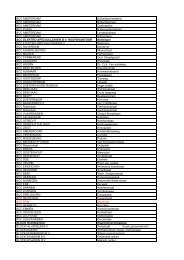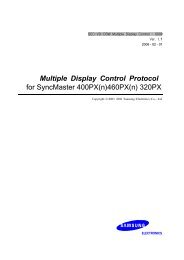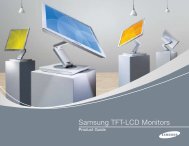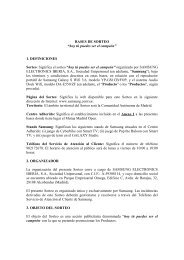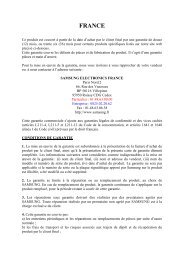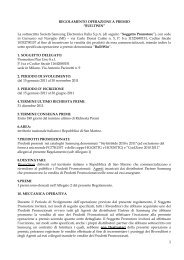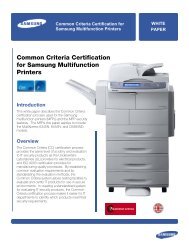2 / Samsung Electronics Sustainability Report 2012 /
2 / Samsung Electronics Sustainability Report 2012 /
2 / Samsung Electronics Sustainability Report 2012 /
Create successful ePaper yourself
Turn your PDF publications into a flip-book with our unique Google optimized e-Paper software.
Green Operation Sites<br />
Operation-Site Environmental Management Structure<br />
Policies and Strategies<br />
<strong>Samsung</strong> <strong>Electronics</strong> is conducting a lifecycle environmental impact assessment on our business activities in order to contribute to global ecosystem<br />
protection through measures from reductions in GHG emissions to recycling of waste water. We have implemented various systems including a lifecycle<br />
pollution control system, environmental risk elimination, and preventive measures in order to minimize environmental impacts and to prevent<br />
environmental accidents.<br />
Targets and Assessment of Achievements<br />
The EHS Strategy council is held on a regular basis to make policies on prevention of EHS accidents and the environment and safety risk assessment. The<br />
council reviews and analyzes global environmental guidelines, national policies, and makes decisions on relevant corporate policies. It reviews achievements<br />
on green management of operation sites and shares the best practices to bring sustained improvement in <strong>Samsung</strong> <strong>Electronics</strong> EHS standards.<br />
Each operation site has an EHS committee which consists of the top executive in charge of operations and EHS experts for the implementation of decisions<br />
made by the council and to resolve related issues. All decisions made by the committee are openly disclosed to all employees. <strong>Samsung</strong> <strong>Electronics</strong><br />
holds a “Global EHS/Utility Conference” with EHS and utility management and staffs on a regular basis. The participants share EHS strategies, regulation<br />
changes, stakeholder demands, new technologies and best practices to contribute to the overall EHS management at <strong>Samsung</strong> <strong>Electronics</strong>.<br />
KPI Target and Performances<br />
Item<br />
Achievement in 2011<br />
2015 targets<br />
Implementation<br />
strategies<br />
1 Scope: 38 production plants (Korea: 9, Global: 29)<br />
2 Excluding LCD business division which has become a subsidiary company as of April <strong>2012</strong><br />
Environment and Safety Risk Assessment<br />
International organizations and NGOs are introducing guidelines on human rights and environmental protection. Countries where <strong>Samsung</strong> <strong>Electronics</strong><br />
has production plants are strengthening policies on environmental protection and occupational safety. We are monitoring changes in international<br />
policies and regulations to proactively respond. Moreover, we are increasing our efforts to eliminate environmental risks at the source.<br />
Risk Analysis and Response Process<br />
Information Collection<br />
Changes in policies & market<br />
Changes in internal conditions<br />
24 / <strong>Samsung</strong> <strong>Electronics</strong> <strong>Sustainability</strong> <strong>Report</strong> <strong>2012</strong> /<br />
Management System Certifi cation Received (%) 1<br />
ISO 14001<br />
OHSAS18001 ISO 50001<br />
100<br />
100<br />
100<br />
100<br />
13<br />
100<br />
Standardize Management System<br />
Acquire ISO 14001 certifi cation for new business sites within<br />
one year of establishment<br />
Impact Analysis<br />
Analysis of fi nancial and nonfi nancial risks<br />
and opportunities<br />
Waste (Korea)<br />
Re-utilization rate (%) Emissions relative to sales<br />
(tons/KRW 100 million)<br />
94<br />
95<br />
Establish resource recycling-based system<br />
Reduce amount of waste generated<br />
Response Activities<br />
Establishment/implementation of<br />
response plan<br />
0.43<br />
10% reduction over<br />
previous year2 Water Resource (Korea)<br />
Water use relative to sales<br />
(tons/KRW 100 million)<br />
91<br />
50 tons/KRW 100 million<br />
maintain 2009 level2 Secure stable water supply<br />
Increase water recycling<br />
Monitoring<br />
Performance check and data collection<br />
Establishment of rules and processes



